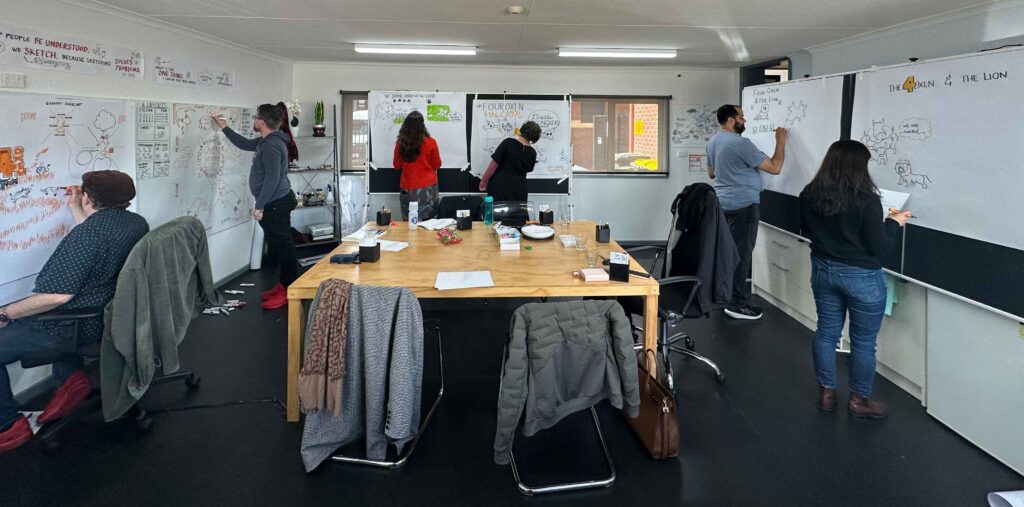Imagine this: You’ve meticulously prepared a business presentation, but as you begin, you notice your audience’s attention waning… Despite your hard efforts, engagement is low, and your key messages are overshadowed by text-heavy powerpoint slides. So how can you transform your presentations from mundane to memorable? Visual thinking training offers a solution, enabling businesses to communicate ideas more effectively, capture their audiences’ attention, and leave lasting impressions.
The Problem with Traditional Presentations
We’ve all sat through dull presentations—endless slides filled with text, a speaker reading verbatim from the screen, and an audience struggling to stay engaged. Despite the presenter’s expertise, the message gets lost in the monotony. The reality is, traditional presentations often fail to capture attention and communicate ideas effectively.
Common pitfalls include:
- Overloaded text on slides – When slides are packed with too much information, audiences focus on reading rather than listening.
- Lack of visual appeal – Plain bullet points and dense paragraphs make it difficult to retain key messages.
- Diminishing attention spans – Studies show that audience engagement starts to decline after just 10 minutes.
Without engaging visuals, information overload sets in, making it harder for audiences to process and remember key takeaways. Visuals, on the other hand, can simplify complex ideas, enhance retention, and make presentations far more impactful.
What is Visual Thinking and Why Does It Matter?
Visual thinking involves using images, diagrams, and metaphors to communicate ideas, rather than relying solely on text. Its significance in business includes:
- Simplifying complex ideas: Visuals make abstract concepts more accessible.
- Enhancing memory retention: Visual aids have been found to improve learning by up to 400%.
- Breaking language barriers: Images transcend language, facilitating clearer communication across diverse teams and cultures.

Visual Thinking Strategies for Business Success
To harness visual thinking in business, consider these strategies:
1. Mapping Your Ideas
Utilise mind maps or flowcharts to organise and structure thoughts visually. These tools aid in brainstorming sessions, project planning, and workflow design.
2. Visual Shortcuts
Simplify explanations using icons and diagrams. For instance, replacing a lengthy paragraph with a straightforward process flow diagram enhances clarity.
3. Visual Metaphors
Employ relatable symbols to convey complex messages. Example: An iceberg for hidden challenges.
4. Tailoring Visuals to Your Audience
Adjust your visual style based on your audience’s preferences. Abstract visuals may suit strategic discussions, while process-driven diagrams might be more effective for operational teams.
Types of Visuals That Work Best in Business Presentations
Incorporating the right visuals into your presentations can significantly enhance engagement and comprehension. But not all visuals are equally effective—choosing the right format depends on the message you’re conveying. Here are some of the best types of visuals to use:
- Infographics: Great for simplifying complex data into an easy-to-digest format. Ideal for summarising survey results, trends, or step-by-step processes.
- Diagrams: Perfect for illustrating relationships, workflows, or hierarchies, making abstract concepts more concrete.
- Charts & Graphs: Help translate raw numbers into visual insights, making financial reports and performance metrics clearer.
- Icons & Illustrations: Add clarity and personality, reinforcing key messages and breaking up text-heavy slides.
- Visual Metaphors & Storyboards: Use symbols and metaphors (e.g., a piggy bank to save money) or sequential visuals to make ideas more relatable and memorable.

The Key to Effective Visuals: Simplicity
Cluttered designs can distract rather than inform. Keep visuals clean, clear, and purposeful to enhance understanding and engagement. By integrating the right visuals, you can turn dull presentations into compelling, persuasive storytelling tools.
The Benefits of Visual Thinking for Your Business
Beyond enhancing presentations, visual thinking training offers additional advantages:
- Boosts creativity and problem-solving: Visual methods can stimulate imagination, enabling users to process information faster.
- Enhances collaboration: Visual communication fosters better teamwork through brainstorming, whiteboarding, and real-time idea-sharing.
- Increases persuasiveness: Presentations using visual aids were found to be 43% more persuasive than unaided presentations.
- Strengthens overall communication: Visual thinking benefits various aspects of business, from internal meetings to client pitches.


Effective communication is vital in today’s fast-paced business environment. Visual thinking training empowers professionals to create engaging, impactful presentations that resonate with their audiences.
Ready to elevate your business communication? Explore how Sketch Group can help you integrate visual thinking strategies and images into your presentations. Click HERE to learn more about our visual thinking training programs.

